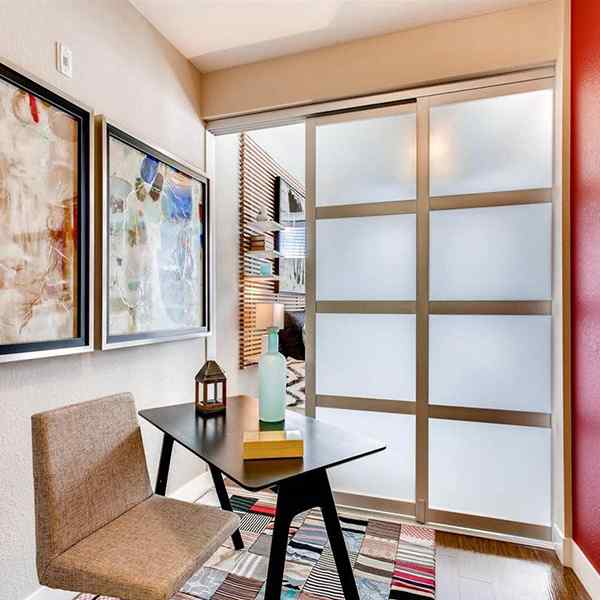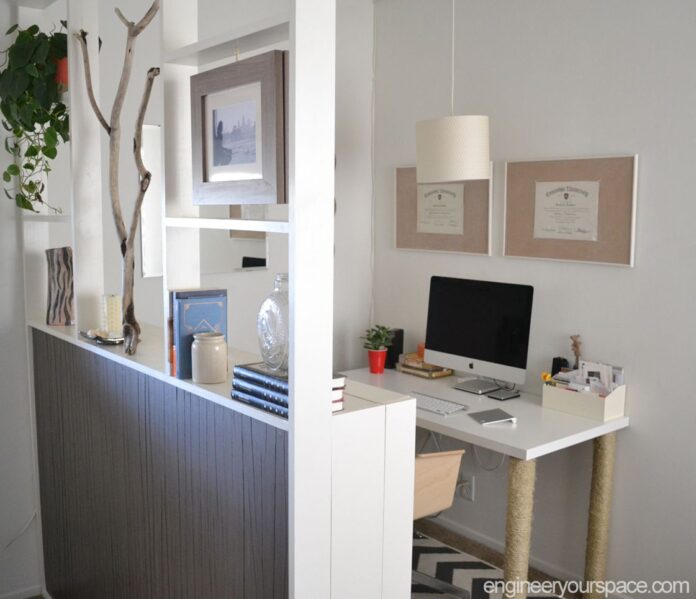If you work from home, chances are your office is in a room that’s shared with another activity. Maybe it’s the dining room table or the corner of the living room. But if you want to create a dedicated workspace, consider using a room divider to define your office area.
Room dividers come in all shapes and sizes, from simple folding screens to elaborate built-ins. And they’re not just for looks—many offer storage options, too.
If you work from home, chances are you don’t have a dedicated office space. That can make it difficult to stay focused and get work done. One solution is to create a makeshift office space by setting up a room divider in your home.
A room divider can help to define your workspace and make it feel more like a traditional office. It can also help to reduce distractions and increase your productivity. If you’re looking for a way to maximize your home office space, consider using a room divider.

Credit: www.slidingdoorco.com
What Can I Use Instead of a Room Divider?
There are a few things you can use as an alternative to room dividers. You could use furniture like couches or bookshelves to divide up space. You could also use curtains or blinds to create divisions between spaces.
If you want something a little more permanent, you could always install some drywall to create new walls within your home. Whatever route you choose, make sure it works for the specific layout of your home and creates the look and feel that you’re going for.
How Do You Divide a Room in an Office?
When it comes to dividing a room in an office, there are a few things you need to keep in mind. First, consider the layout of the space and how you want to use it. If you have a large open space, you may want to consider creating smaller, more intimate areas within it.
This can be done by using furniture or partitions to break up the space.
Another thing to keep in mind is what kind of atmosphere you want to create in your office. If you want a more relaxed and informal feel, then you might not need to divide the space as much.
However, if you’re looking for a more professional environment, then dividing the space into smaller areas can help create that feeling.
Finally, think about what kind of budget you have for this project. Dividing a room can be expensive, so if you’re on a tight budget you may want to look into other options such as painting walls or using curtains instead of partitions.
With a little bit of planning and creativity, divided spaces can be both functional and stylish!
What is a Japanese Room Divider?
A Japanese room divider, also known as a shoji screen, is a traditional piece of Japanese furniture used to divide up space and provide privacy. Shoji screens are made from a frame of wood or bamboo covered with translucent paper or fabric, and are often decorated with intricate designs. Japanese room dividers can be freestanding or mounted on walls, and are available in a variety of sizes to suit any space.
Shoji screens were first introduced to Japan during the Heian period (794-1185), when Chinese immigrants brought them over as part of their culture. The use of shoji screens quickly spread throughout Japan, where they became an essential part of traditional Japanese architecture. Today, shoji screens are still used in many homes and businesses across Japan, both for their practicality and aesthetic appeal.
If you’re looking for a way to add some privacy and division to your home or office space, then a Japanese room divider is definitely worth considering. With their unique style and functionality, these versatile pieces of furniture offer much more than just a simple way to section off areas – they’re also an important part of Japanese culture and history.
How Do I Build a Privacy Room Divider?
There are a few things you need to consider when building a privacy room divider. First, you need to decide what type of divider you want. There are many different types of room dividers, including folding screens, curtains, and solid walls.
Once you’ve decided on the type of divider you want, you’ll need to measure the space where it will go and choose the material. Room dividers can be made from a variety of materials, including wood, fabric, metal, or glass.
If you’re handy with tools, you can build your own privacy room divider using plywood and some basic hardware.
If not, there are plenty of ready-made options available for purchase online or at your local home improvement store.
How to make a temporary room divider with IKEA Billy bookcases to create a home office
Best Room Dividers for Home Office
When working from home, it’s important to have a designated space that’s separate from the rest of your living area. Room dividers are a great way to create a boundary between your work and leisure areas. Not only do they provide privacy and help reduce distractions, but they can also add style and character to your home office.
There are many different types of room dividers available on the market, so it’s important to choose one that best suits your needs. If you’re looking for something lightweight and portable, fabric room dividers are a good option. These come in a variety of colors and patterns, so you can easily find one that complements your existing décor.
For more substantial privacy, wooden or glass room dividers are a better choice.
If you have an open floor plan, consider using a bookshelf or screen as a room divider. This way, you can still see through the divider while creating a defined space for your home office.
Whatever type of room divider you choose, make sure it’s tall enough to block out distractions and allow you to focus on your work.
Conclusion
Working from home has become the new normal for many of us. But if you don’t have a dedicated home office, it can be tough to find a quiet place to get work done. That’s where a room divider comes in handy.
A room divider is a great way to create a makeshift office in any room of your house. It can provide privacy and noise reduction, so you can focus on your work. Plus, it’s a stylish way to divide up space in your home.
There are plenty of room dividers on the market, so you’re sure to find one that fits your needs and budget. From portable partitions to permanent walls, there’s an option for everyone.


